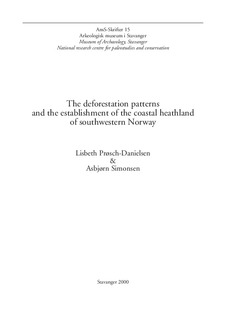| dc.contributor.author | Prøsch-Danielsen, Lisbeth | |
| dc.contributor.author | Simonsen, Asbjørn | |
| dc.date.accessioned | 2012-10-04T11:59:37Z | |
| dc.date.available | 2012-10-04T11:59:37Z | |
| dc.date.issued | 2000 | |
| dc.identifier.citation | Prøsch-Danielsen, L. og Simonsen, A. (2000). The deforestation patterns and the establishment of the coastal heathland of southwestern Norway. Stavanger : Arkeologisk Museum. | no_NO |
| dc.identifier.isbn | 82-7760-076-3 | |
| dc.identifier.issn | 0800-0816 | |
| dc.identifier.uri | http://hdl.handle.net/11250/181429 | |
| dc.description.abstract | Palynological data collected over a period of 60 years have been compiled and re-interpreted in order to reveal the
deforestation patterns and heath establishment in the southwestern Norwegian coastal heathland. This heathland
area has been divided into four sub-regions based on topography, bedrock and coverage of Quaternary deposits.
The palynological sites represent different sizes of catchments reflecting both local, extra-local and regional pollen
source areas. They are represented by ancient monuments, soil profiles, bogs and lakes. The palynological signals
of deforestation and heathland establishment can be described by different models indicating an abrupt, gradual
or stepwise deforestation. The differences between these models can be explained by the size of the catchments.
The deforestation seems to have been metachronous, leading to a regional mosaic pattern of different vegetation
types. The process spanned more than 3600 years, from 4000 cal BC to 400 cal BC, with three pronounced
clearance periods: 4000–3600 cal BC (Mesolithic/ Early Neolithic transition), 2500–2200 cal BC (Middle Neolithic
II/ Early Late Neolithic transition), and 1900–1400 cal BC (Late Neolithic to Bronze Age period II). The
development of heathland in the outer coastal area that followed deforestation has also been metachronous and
took place over a period of approximately 4000 years from 4000 cal BC to 200 cal BC, but was mainly completed
during the Bronze Age. Regional differences in the deforestation pattern and heathland establishment are discussed
with respect to chronology. The progression of the deforestation can best be explained by the interaction of
human manipulation, topography and edaphic conditions. Climatic variations seem to be of less importance. | no_NO |
| dc.language.iso | eng | no_NO |
| dc.publisher | Arkeologisk Museum i Stavanger | no_NO |
| dc.relation.ispartofseries | AmS-skrifter;15 | |
| dc.subject | arkeologi | no_NO |
| dc.subject | avskogning | no_NO |
| dc.subject | lyngheier | no_NO |
| dc.subject | vegetasjon | no_NO |
| dc.subject | paleobotanikk | no_NO |
| dc.subject | kulturlandskap | no_NO |
| dc.title | The deforestation patterns and the establishment of the coastal heathland of southwestern Norway | no_NO |
| dc.type | Book | no_NO |
| dc.type | Peer reviewed | no_NO |
| dc.subject.nsi | VDP::Humanities: 000::Archeology: 090::Nordic archeology: 091 | no_NO |
